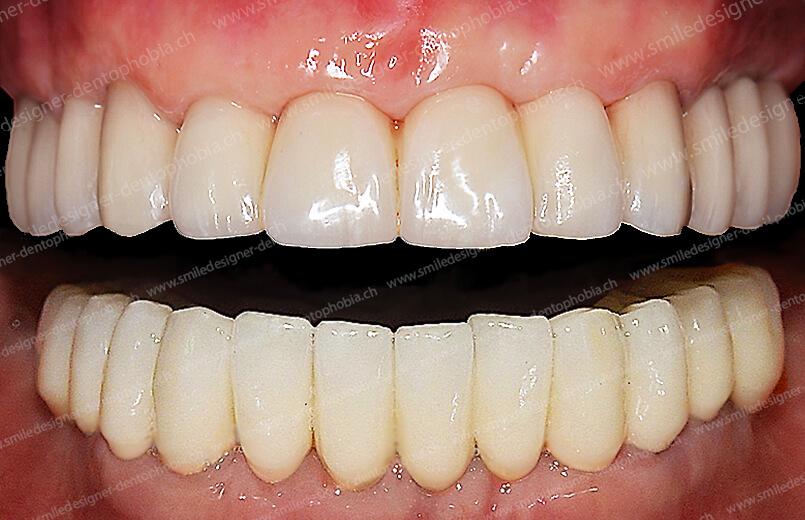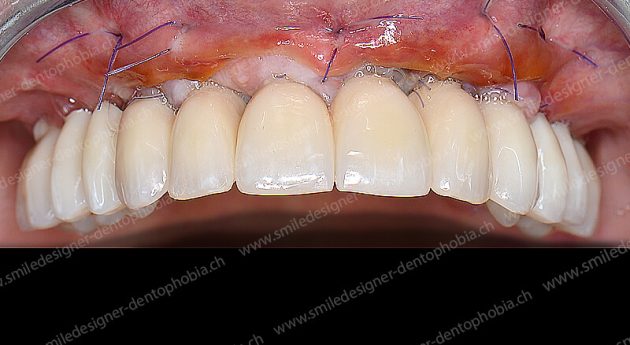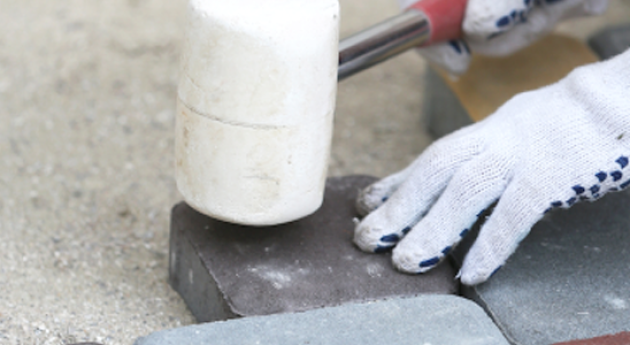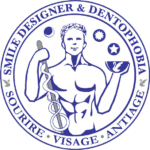YOUR NEW SMILE IN ONE WEEK
the choice according to your aesthetic requirements
A PROTOTYPE MCI RESILIENT BRIDGE FOR OSSEOINTEGRATION
AN MCI CERAMIC BRIDGE FOR THE AESTHETIC RESULT
OUR choices of implant-supported bridges in immediate loading
a range of new SMILE according to your requirements

"THE PLEASURE OF LIFE IS TO CHOOSE WHILE SEEMING TO IGNORE CHANCE.
MARCEL AYMÉ
THE RESILIENT BRIDGE IS FIXED POST-OP ON YOUR IMPLANTS
it is a FIRST INTENTION prosthesis in immediate loading
IN A FEW DAYS, THIS PROTOTYPE WILL BE YOUR NEW SMILE
WE GIVE YOU TIME to make the transition to a permanent bridge
CHOOSE THE SMILE OF YOUR DREAMS
The dilapidated clinical situation of your teeth was so worrying that you were forced to undergo surgery as soon as possible in order to regain a minimal masticatory function and an aesthetic smile, which prevented your desocialization.
An “MCI resilient bridge” was fixed
on the implants
a few days after their placement
surgical placement.
This implant-supported bridge with a resilient PMMA or acrylic glass cosmetic on a titanium frame is a fixed prosthesis
in
It is a prosthesis fixed in first intention during the healing and maturation of the hard and soft tissues around the implants, which will last between six months and one year.
It appears that its mechanical and aesthetic performance and aesthetic performance gives you the necessary time, even after the healing period, to organize yourself personally and financially, in order toThis will allow you to move towards an MCI bridge with a cosmetic ceramic veneer with the least amount of stress.
To a certain extent, thishe implant-supported bridge with a resilient cosmetic made of PMMA or acrylic glass could be considered semi-definitive, since its lifespan can sometimes be extended.
But be careful, this resilient PMMA bridge bridge is not intended to be permanent: its function is to be a prototype to search for the aesthetics of your smile and your masticatory functions, both of which have undoubtedly been lost during your life.
It serves primarily as a guide for hard and soft tissue healing, as well as testing your bite and the aesthetics of your smile and face.
Its vocation is to be replaced by a final version with a ceramic cosmetic.
Some patients retain this first-line bridge or “MCI resilient bridge”, with a cosmetic dressing in acrylic glass (PMMA) beyond the healing time. However, this is mainly due to financial blockages. The goal of our protocol is to reach the “Gold Standard MCI” with a ceramic cosmetic MCI bridge.
However, since the “Resilient MCI Bridge” with a cosmetic veneer made of acrylic glass (PMMA) is comfortable and aesthetically pleasing, patients have plenty of time to make financial arrangements .
His dThe life span is quite long. It can even be extended, on the patient’s request, thanks to a reappearance in the laboratory, after the bone healing phase.
As a result, the “MCI Resilient Bridge”, the first version of the MCI bridge with a PMMA cosmetic coating fixed in could be kept on the implants on the implants for several years, should the need arise. With regular maintenance and possible reconditioning in the dental laboratory, its life span can be extended at a reasonable cost.
The “MCI Resilient Bridge” vhe MCI Resilient Bridge” allows you to enjoy a new smile during this period of healing and reflection, while thinking about how to make it even better.
However, these “extensions” have a time limit. Most of our patients obviously wish to have their smile evolve towards the second definitive version of the implant-supported screw-retained bridge with a ceramic cosmetic covering.
This second ceramic version of the implant-supported bridge is the culmination of the MCI protocol, both for obvious esthetic reasons and for functional reasons of masticatory power and mechanical resistance. In addition, the biological tolerance of the “ceramic” material is much higher than that of the resin. PMMA, like other resins, is quickly contaminated with bacteria.
However, it will take a minimum of 6 to 12 months to have perfect osseointegration of the implants in your jawbone and restructuring of the bone grafts and soft tissue. This is the time to wait before considering replacing the first version of the resilient bridge with a second version of the bridge with a cosmetic ceramic veneer.
THE RESILIENT BRIDGE OF FIRST INTENTION: THE PROTOTYPE
ESSENTIAL FOR THE OSSEOINTEGRATION OF MCI IMPLANTS

This resilient immediate-loading bridge or IOL will be placed between 4 and 10 days after the procedure in the office or in the operating room.
Please note that it is okay to place the bridge up to 10 days after surgery if additional time is required by the laboratory. Physiological postoperative osteolysis begins after 15 days.
This is the minimum time required for the laboratory to produce a high-quality implant-supported bridge.
It is screw-retained implant-supported: i.e. fixed by semi-permanent screwing on the implants. It can be removed by unscrewing it in the cabinet, if necessary.
The implant-supported screw-retained bridge is manufactured in a highly specialized dental laboratory equipped with CAD/CAM (Computer Aided Design and Manufacturing). It consists of a metal skeleton, made with the help of the latest generation of digital CAD/CAM.
A3D CAD/CAM metal printer fabricates the skeleton/framework with such precision that it is completely passive mechanically once it is screwed into the implants.
Then, this skeleton is dressed with a cosmetic made of acrylic glass or PMMA material, perfectly mimetic of a beautiful dental aesthetic.
It is resilient and biocompatible.
The acrylic glass material of the PMAA family is also sculpted using CAD/CAM technologies.
Thanks to the aesthetic qualities of PMMA, the implant-supported screw-retained bridge mimics the aesthetics of natural teeth almost as well as a bridge with acosmetic ceramic veneer .
The only drawback is that PMMA material is “soft”. It is therefore less resistant and less durable over time, with less chewing force and less aesthetic brilliance than cosmetic in dental ceramics
But it is precisely this “disadvantage” that becomes its determining “advantage”.
Indeed, it solves the technical and biological problem of absorbing shock waves that generate micro-movements that are fatal to bone healing, as we will see later.
It is important to understand that this full ICM bridge must replace your entire dental arch: that is, all the teeth in the affected jaw.
It is attached to the intraosseous implants that were placed to replace the roots of the extracted teeth. The corollary of this principle is that one should not compromise in the indication and extract all the teeth in the arch. If there are a small number of residual teeth that are not strictly speaking suitable for immediate extraction, the protocol requires that these teeth be extracted and “sacrificed” to replace the entire dental arch.
This MCI bridge, covered with a resilient and biocompatible acrylic glass material. It is a first version of high level mechanical, biological and aesthetic restructuring of your smile.
WHY IS THE MCI RESILIENT PMMA BRIDGE OF FIRST INTENTION INCONTROVERTIBLE?
There are two requirements for implants to heal in the bone, which seem to be a real dilemma. That is, two contradictory premises with no apparently compatible solution.
The first requirement for healing: the need for an implant-supported bridge with a very ” rigid ” skeleton to lock the implants in the bone and allow bone healing, which is called osseointegration.
In order to protect the implants screwed into the soft (cancellous) bone of the jaws from micromovements of more than 200 microns, it is necessary to have an implant-supported bridge with a central spine: a metalframework very ” rigid “. This beam metal manufactured by CAD/CAM, connects each implant to each other in a extremely precise way in order to lock them into the bone.
This immobilization of the implants embedded in the bone, with a tolerance of less than 200 microns, will allow the bone to heal, which is called “osseointegration of the implants”.
This ” immobilization bone” by a metal fixation is the basis of the biological principle of bone healing by osteosynthesis.
It is used in orthopedics : the orthopedic surgeon screws orthopedic pins into a fractured long bone (arm or leg) to fix the mobile fractured bone pieces. He adds a “plaster” as a possible complement.
In MCI implantology, the equivalent of our ” cast and pins ” is the MCI bridge itself, which immobilizes the implants in relation to each other, just as a fence rail immobilizes the posts.
The second requirement for healing: the need to manufacture ” the bridge teeth ” in a “soft and tender” material such as acrylic glass or PMMA which absorbs shocks and vibrations.
It is imperative to protect the implants from the shock waves created by the hard clash of teeth against each other during chewing, teeth grinding at night and also during our two thousand daily swallows.
The PMMA resilient material acts as a mechanical suspension, i.e. an elastic device designed to absorb shocks
In conclusion :
The manufacturing technologies of the MCI resilient implant-supported bridge, with a cosmetic coating made of acrylic glass (PMMA), solve the dilemma and make it possible to satisfy the two apparently contradictory requirements for healing.


THE TECHNICAL SOLUTIONS REQUIRED FOR IMPLANTOLOGY IN MCI
The synergy between the new 3D CAD/CAM digital machining technologies and the new generation of dental biomaterials: titanium metal alloys and acrylic glass.
Titanium-based metal alloys and acrylic glass are two biomaterials that can be sculpted using digital machining equipment connected to computers: this is the principle of CAD/CAM.
The rigidity and passivity of the metal framework combined with the resilience of acrylic glass (PMMA) creates a synergy that revolutionizes the old paradigms of implant-supported prosthetics.
This synergy of the mechanical properties of these two materials protects the implants from shock waves and mechanical movements of more than 200 microns, which are fatal to the osseointegration of the implants.
The rigidity of the metal spine of the implant-supported bridge allows for the absence of torsion or bending, which is necessary for the passivity of this structure on the implants.
On the contrary, acrylic glass (PMMA) is a material that is more ductile (malleable). It absorbs the shocks of chewing much better than dental ceramics, which are much harder and transmit the shock waves to the implants and therefore to the bone still healing around them.
For this reason, acrylic glass is the cosmetic dressing of choice in the first instance, during the healing period of implants placed in the bone.
In contrast, the ceramic veneer of the second metal skeleton, fabricated in the same way using CAD/CAM technology, is the standard for the second-line implant-supported bridge.
However, the physical and chemical properties of acrylic glass are so good that the resilient PMMA bridge could be considered, in certain exceptional circumstances, as a very long-lasting implant-supported prosthesis.
However, the qualities of dental ceramics are far superior to any other cosmetic for dental bridges, especially in the long term.
Why can the resilient acrylic glass bridge fixed in the first instance be considered as a long-term implant-supported prosthesis?
The great aesthetic and mechanical qualities of acrylic glass (PMMA) allow it to be considered as a long-term implant-supported prosthesis solution, in first intention.
Even though dental ceramics is the most aesthetic, biocompatible and long-lasting material.
As a rule, the choice to keep the first PMMA bridge is mainly guided by financial considerations in order to save the cost of a second ceramic bridge after six to twelve months, even though it is better in all respects.
Most people would like to have access to a final, more advanced and more effective solution: an implant-supported bridge with a ceramic cosmetic covering.
However, the resilient MCI bridge can, in certain favorable cases, “do the job”, until this first version of the bridge can be replaced by a second version in ceramic
However, it is necessary to wait for the final healing of the implants (called osseointegration). This means that you must wait at least eight months after the first operation and the installation of the resilient MCI bridge.

REPLACEMENT OF THE RESILIENT BRIDGE OF FIRST INTENTION
BY AN IMPLANT-SUPPORTED BRIDGE WITH A CERAMIC VENEER
AFTER THE OSSEOINTEGRATION PHASE OF THE IMPLANTS


DURING YOUR MCI PROTOCOL WE OFFER YOU SEVERAL PROSTHETIC SOLUTIONS
We offer several prosthetic solutions, all of which are satisfactory but with advantages and disadvantages. They are proposals for answers to different problems, with specific aesthetic and functional performance gradients for each of them.
There are three main cases :
1 – In the first The first version of the MCI bridge in PMMA fixed in first intention determines a mastication, a vertical dimension of occlusion and an aesthetic of the smile and the face which is convenient for you and/or seems sufficient.
In this case, this version can be considered as the definitive aesthetic and functional project without any alterations. However, this case is quite “lucky”. It can only be conceived for people with aesthetic and chewing constraints, quite simple.
The complexity of the protocol of implant placement in MCI, the search for harmony and aesthetics of the smile and face, fits rather badly with this “one shot”. We show beautiful results clinical, but they are, in reality, the result of a very big work. You can get lucky in the lottery, but a real post-surgical programming is more certain.
For as much, the chance is possible and the worst is not certain…
On the other hand, and obviously, it cannot be a “contractual project”.
Since the patient’s comfort is measured by the postoperative clinical results. The decision of the patient to keep the first version of the resilient MCI bridge as is or to modify it is subjective.
And if he makes the decision to keep her longer than necessary, it is usually based on hispersonal financial constraints.
2 – In the second This first version of restructuring with an MCI bridge in PMMA seems to you globally satisfactory, but corrections are necessary .
The first version of your smile restructuring with a PMMA MCI bridge is a “prototype” of the final bridge.
It is designed to allow aesthetic and functional corrections in order to optimize all the physiological and aesthetic parameters and integrate them into the equation of the new definitive bridge, with a cosmetic ceramicveneer.
So of course, corrections are possible at the office “in mouth” and/or by the laboratory.
If any , aesthetics or occlusion, then this PMMA implant-supported bridge can be retouched and corrected in the laboratory within a few days in the office “in the mouth”.
But, by the laboratory, only after complete osseointegration of the implants. That is, at least six months after the installation. Previously, it cannot be unscrewed because of the risk of de-integration of implants. This makes the correction operations very complicated.
Extensions :
If, due to special personal circumstances, you wish to keep the first version of the PMMA MCI bridge fixed in longer than the normal healing period, it is theoretically possible to extend its lifespan.
MCI bridges made of PMMA cannot be be guaranteed beyond the normal healing phase.
For all thatin case of cosmetic problem over time, it is theoretically possible to clean, repolish and / or redo completely the worn acrylic glass cover. The clinical case and practice validate the theory or not!
In the best of cases, this process requires one week of work at the laboratory for a cost at your charge and according to estimate, which can reach several thousands of euros if all the cosmetics must be redone.
In the latter case, it is preferable to go directly to the final bridge implant-supported with a cosmetic ceramicveneer.
3 – In the third case: Because your aesthetic and functional desires are the most demanding, this version of the MCI bridge in PMMA must naturally evolve towards a version of implant-supported bridge with a dressing cosmetic ceramic more successful and efficient both functionally and aesthetically.
In the latter case, a second version of the bridge, this time with a dental ceramic veneer, replaces the first of the bridge, this time with a dental ceramic veneer, replaces the first version in PMMA.
If your high aesthetic and/or functional requirements demand it, this first version of the implant-supported bridge with a cosmetic veneer resilient acrylic glass veneer, should be naturally replaced by a second version of the implant-supported screw-retained bridge, with a cosmetic cosmetic veneer ceramic veneer but only after a minimum of 8 months of healing.
BEWARE OF SHOCKS with cosmetic ceramics: you must wait eight months
The hard and repeated shockwaves of chewing on the MCI bridge version, with aceramic
cosmetic ceramics
,
are reflected along the structure of the bridge and the implants.
This is mortifying for the development of neoformed bone tissue along the implants and therefore, impairs the osseointegration of the bone around the implants and leads to failure.
For this reason, it is necessary to wait between 6 and 12 months for bone healing and bone and gingival remodeling around the implants and the MCI bridge structure before opting for the ceramic version of the MCI implant-supported bridge.
It is also necessary to have a strictly soft diet during the entire healing phase. That is, eating food that can be chewed between the fingers.




